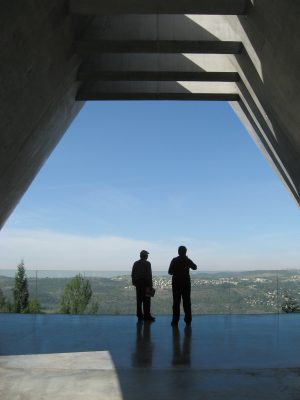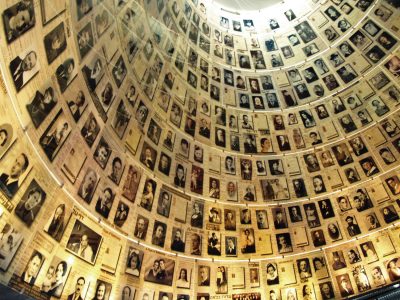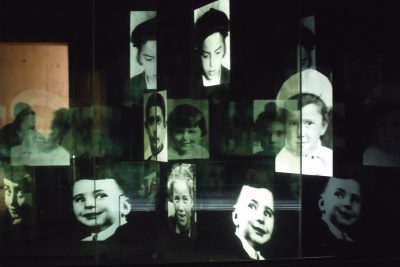×


We have detected your country as:
Please click here to go to the USA website or select another country from the dropdown list.
by: Kathy DeGagne, BFP Staff Writer
 Seldom does a building of concrete and glass so poignantly mirror what goes on inside its walls. Yad Vashem, the Holocaust Museum in Jerusalem, is more than a museum. It is an architectural gem where structure and setting serve as an evocative backdrop to the Holocaust story.
Seldom does a building of concrete and glass so poignantly mirror what goes on inside its walls. Yad Vashem, the Holocaust Museum in Jerusalem, is more than a museum. It is an architectural gem where structure and setting serve as an evocative backdrop to the Holocaust story.
Carved into the Landscape
The museum, designed by Israeli-born architect Moshe Safdie, is set in a complex of buildings dedicated to the memory of the six million Jewish victims of the Holocaust. The museum itself is a straight, long arrow of triangular concrete and glass buried into the crown of a hill called Har HaZikaron (Hill of Remembrance). The slashing of the mountain by the building itself echoes the painful history of the Jewish people indelibly etched into the heart of every Israeli. Each end of the building juts out of the mountain into thin air—the northern end flared like the wings of a butterfly emerging from its chrysalis.
I invite you to walk through Yad Vashem with me.
A Descent into Darkness
As we descend from Jerusalem’s bright daylight into the museum’s subterranean interior, there is the sound of a children’s choir singing “HaTikvah” (“The Hope,” Israel’s national anthem), recorded in pre-war Czechoslovakia. Most of these children did not survive the Holocaust.
We move through the exhibition galleries that emerge off the central triangular-shaped corridor, and every emotion, every sense resonates with the tragic narrative as it unfolds. The layout “guides” us through the museum. We go—sometimes rather reluctantly—because at some point, the exhibits, disembodied voices of survivors and videos become just too heavy for our hearts and minds to process. Yet we are drawn by the unique voices of individual Jews who lived within the context of that horror, but whose lives testify to their courage in the face of unspeakable odds.
Halfway through the museum I realize my friend is no longer with me. I find her in a secluded corner, quietly weeping. This is the kind of grief we should all carry in our hearts. Although the evil of the Holocaust happened over 70 years ago, grieving the magnitude of the loss will surely help prevent it from ever happening again.
A Progression of Hope
 Our spirits are surprisingly buoyed every time we cross back through the corridor to another gallery and feel the sunlight beaming down on us from the long skylight overhead. Though physical barriers prevent anyone from breezing straight down the corridor and out the exit at the other end, that brief glimmer of light—of hope—feels stronger as we go through each subsequent gallery.
Our spirits are surprisingly buoyed every time we cross back through the corridor to another gallery and feel the sunlight beaming down on us from the long skylight overhead. Though physical barriers prevent anyone from breezing straight down the corridor and out the exit at the other end, that brief glimmer of light—of hope—feels stronger as we go through each subsequent gallery.
From the galleries that display the first shadows of anti-Semitism in Europe and then the incarceration of the Jewish men, women and children in ghettos and death camps, we now come to the galleries that honor those who resisted the Nazi death machine and the courage of the Jewish survivors who returned to life after the camps. Yad Vashem describes the survivors’ return to life as gathering “the remnants of their vitality and the remaining sparks of their humanity” in order to rebuild. They rebuilt their lives, their families and their homes. Survivor Zvi Kopolovish says in response to the crimes perpetrated against them, raising their new families was their “revenge and consolation.”
Near the end of the corridor is a cone-shaped gallery called the Hall of Names. Yad Vashem literally means “a monument and a name” and describes itself as “the Jewish people’s living memorial to victims of the Holocaust.” The Hall of Names is the gallery that memorializes the names of the Jews who perished. On the conical wall hang the photos of 600 of the six million victims. Below us, the portraits are reflected in a pool of water in an inverted cone bored deep into the mountain, a lasting memorial to those whose names and faces we may never know.
Out of the Darkness
We then ascend up and out of the museum into the light. Before us is a brilliant triangular-framed vista of Jerusalem with blue sky and green hills beyond—a living metaphor for the Jewish people who emerged out of the darkness into light, hope and new life.
We walk along the Avenue of the Righteous, a tree-lined pathway honoring righteous non-Jews who tried to save their Jewish friends, neighbors and people they didn’t even know. The price for harboring Jewish individuals and families was extreme, and many forfeited their own lives. The trees along the avenue are dedicated to these Righteous Among the Nations: Oskar Schindler, Irena Sendler, Chiune Sugihara—and many others, possibly lesser known but no less honored.
Into the Light
 At Yad LaYeled (Children’s Memorial), a building that memorializes the 1.5 million children lost in the Holocaust, we again enter a subterranean tunnel. It seems pitch black inside but for a “night sky” lit by thousands of points of light, each one representing a child’s life. A voice slowly reads the names of the children, and their photos appear out of the darkness. When we emerge into the daylight again, we can only stand still, stricken silent by the power of the experience.
At Yad LaYeled (Children’s Memorial), a building that memorializes the 1.5 million children lost in the Holocaust, we again enter a subterranean tunnel. It seems pitch black inside but for a “night sky” lit by thousands of points of light, each one representing a child’s life. A voice slowly reads the names of the children, and their photos appear out of the darkness. When we emerge into the daylight again, we can only stand still, stricken silent by the power of the experience.
In Moshe Safdie: The Architecture of Memory, Safdie wrote: “Designing the Children’s Memorial had given me an inkling of the power of emerging into light. It meant that life prevailed. For the new museum, cutting through the mountains and bursting northward to provide views of the hills beyond…[brought] this life-affirming experience to another level. To stand on the extended terrace…is to understand that, indeed life prevailed. We prevailed.”
All logos and trademarks in this site are property of their respective owner. All other materials are property of Bridges for Peace. Copyright © 2024.
Website Site Design by J-Town Internet Services Ltd. - Based in Jerusalem and Serving the World.